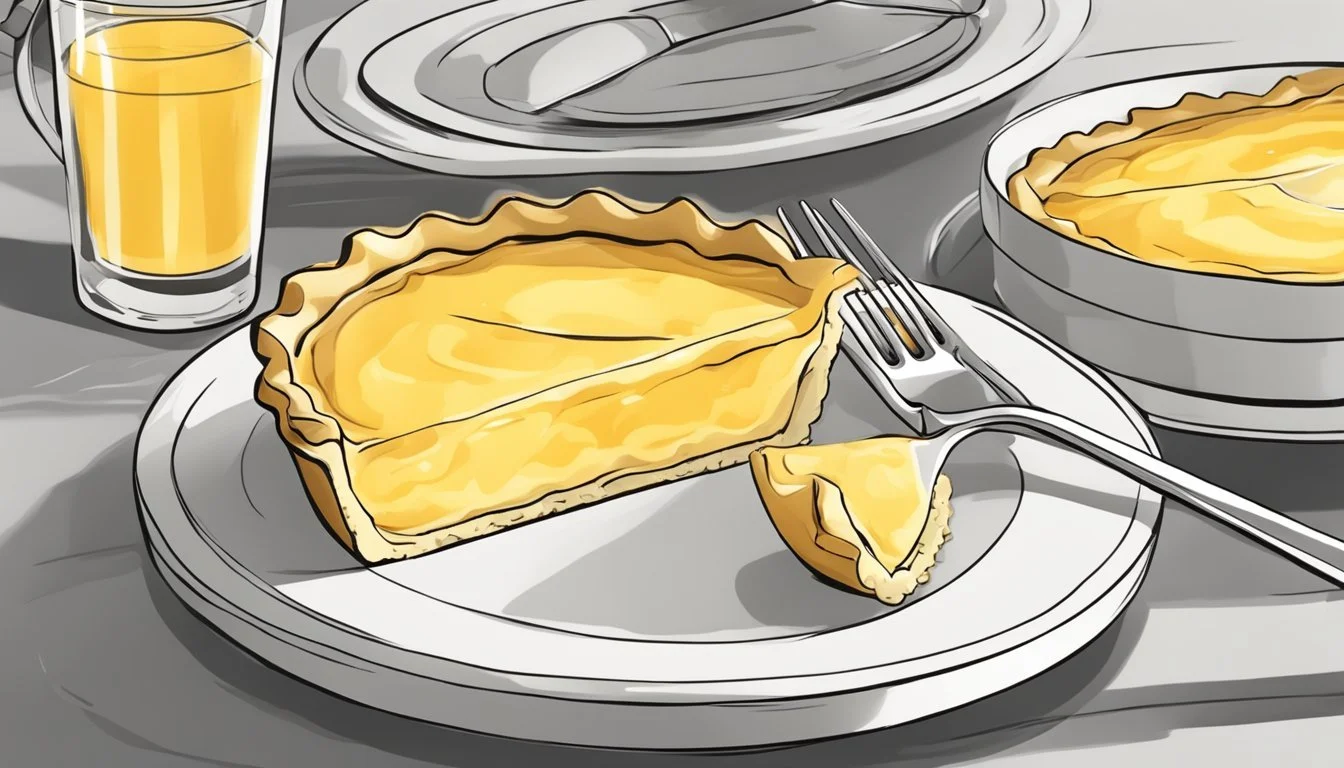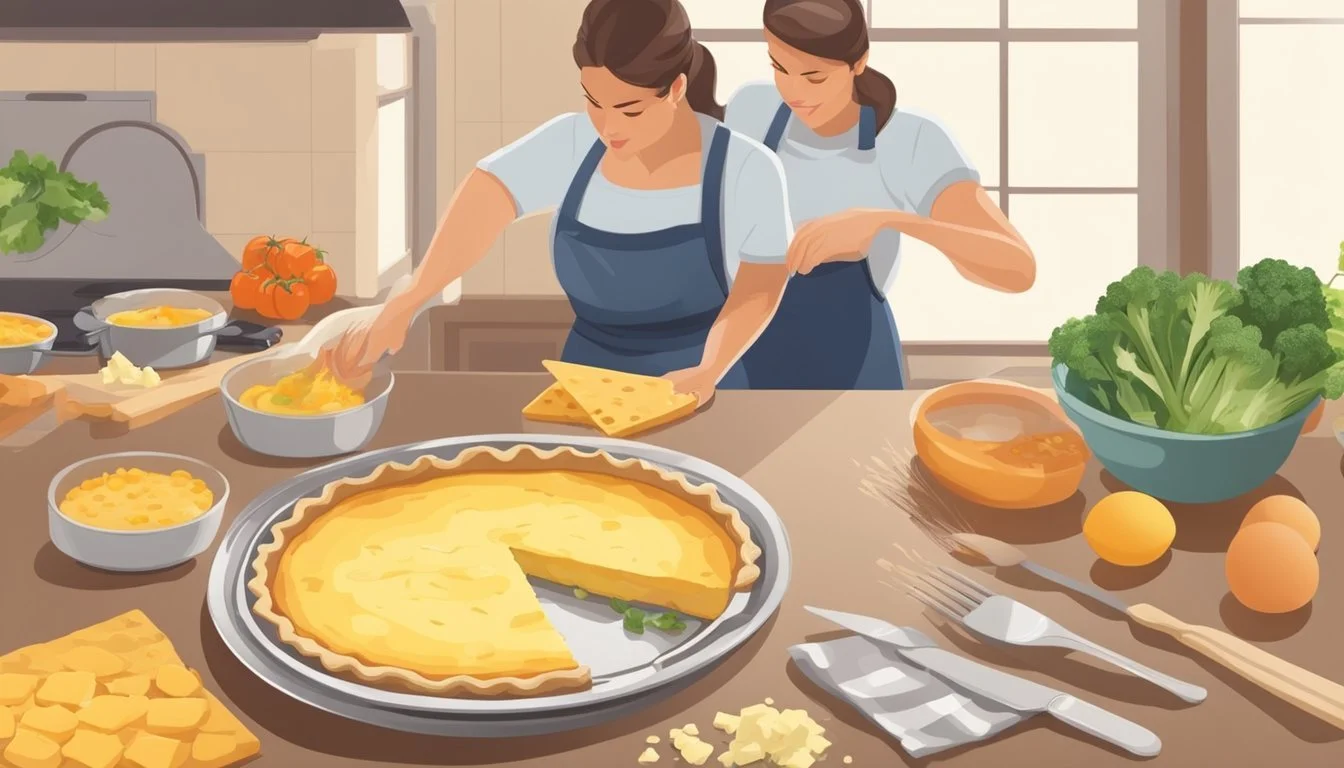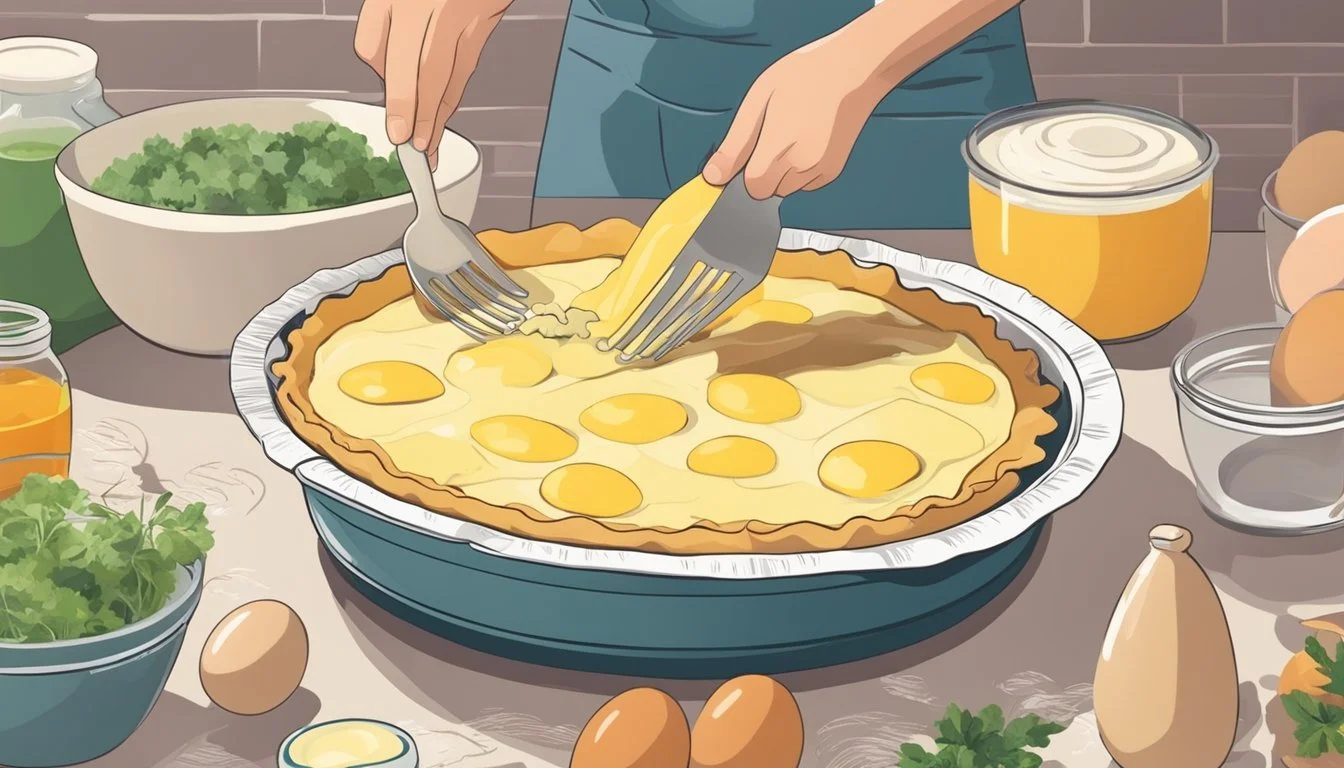How do you eat quiche?
A guide to enjoying this versatile dish
Quiche (What wine goes well with quiche?) is a versatile dish that can be enjoyed in various ways, though it is often debated whether it should be eaten hot or cold. This savory French tart combines eggs, cream, cheese, and other fillings such as meats, vegetables, or seafood, all encased in a buttery pastry crust. Traditionalists may argue for serving it warm to appreciate the delicate, creamy texture of the filling and the flaky crust. However, quiche is also a popular make-ahead meal or picnic dish served at room temperature or even straight from the fridge, offering a different but still enjoyable experience.
Preparation methods affect the ideal consumption temperature of a quiche. When freshly baked, it's advisable to allow the quiche to cool slightly to help the flavors meld and the structure set, making it easier to slice. Reheating a quiche can be done efficiently in a microwave or oven, though care must be taken to avoid overheating, which can compromise texture. On the other hand, enjoying quiche cold emphasizes a firmer texture and can complement the convenience of on-the-go meals or outdoor dining scenarios.
Understanding Quiche
Quiche embodies the delicate balance of hearty filling encased in a flaky pastry crust, a specialty that has transitioned from classic French cuisine to an international favorite.
History and Origin
Quiche finds its roots in the medieval kingdom of Lothringen, Germany, which the French later renamed Lorraine. The term 'quiche' is derived from the German word 'Kuchen', meaning cake. Quiche Lorraine, the original quiche, was a simple open pie with a filling of egg, cream, and smoked bacon (how long does bacon last?). It was only later that cheese was added to the mix. The dish evolved with the region, which oscillated between German and French control, and it thus incorporated elements from both cultures.
French chefs further refined quiche, which gained popularity and became a classic dish in French cuisine. Today, it occupies an esteemed place in both formal and informal French dining.
Quiche Varieties
Quiche showcases a versatile range that caters to an array of tastes. While the Quiche Lorraine remains the archetypal variety, other popular types of quiche have emerged, notable for their diverse ingredients:
Quiche Florentine: Includes spinach, adding a vegetable element to the egg and cream base.
Quiche aux champignons: Features mushrooms for an earthy flavor.
Cheese Quiches: These may incorporate distinctive cheeses such as Gruyère, Emmental, or cheddar.
Other inventive quiche varieties include ingredients like seafood, various meats, and a spectrum of vegetables. Each variant maintains the foundational components of a quiche: a pastry crust and a savory custard filling, which can then be adapted to accommodate a wide range of additional flavors and textures.
Essentials of Quiche Preparation
Crafting a delicious quiche requires attention to detail in ingredient selection, crust creation, and custard blending. Each component must be thoughtfully prepared to ensure the final dish is satisfying and well-balanced.
Choosing Ingredients
For the filling, the choice of ingredients can vary widely, but staples often include eggs, milk or heavy cream, and a combination of cheese, bacon, spinach, and mushrooms. It's crucial to use fresh, high-quality ingredients to enhance flavor. The ratio of eggs to dairy is essential to achieve a creamy texture, with a standard guideline being one egg to every half cup of dairy.
When selecting cheese, consider those that melt well, such as Gruyère or cheddar, adding both flavor and a desirable creamy consistency. Meats like bacon need to be precooked until crispy, while vegetables like spinach and mushrooms should be sautéed and properly drained of excess moisture to avoid a soggy quiche.
Perfecting the Crust
A homemade pie crust starts with a simple dough comprised mainly of flour, fat, and a pinch of salt. For a flakier texture, keeping ingredients cold is key. Once the dough is prepared, it should be rolled out to fit just beyond the edges of a 9-inch tart pan.
It is then pressed into the pan, with excess dough trimmed. To prevent shrinking, the crust should be chilled for 30 minutes prior to baking. Before filling, parchment paper is used to line the crust, which is then filled with pie weights or dried beans to pre-bake, known as 'blind baking', ensuring the bottom doesn't puff up.
Preparing the Custard
The custard mixture is at the heart of every quiche and involves beating together eggs, milk, and/or heavy cream with salt and pepper for seasoning. This can be done with a whisk until combined and air is incorporated, making the texture light and airy. Pouring the custard into the pre-baked crust is a delicate action that requires the pie to be placed on a baking sheet for stability and even heating in the oven.
The oven should be properly preheated, and the quiche should be baked until the custard is just set, avoiding overcooking to keep the texture soft and creamy.
Cooking Techniques
Proper cooking methods are essential for preparing quiche, whether one opts for classic oven baking or explores alternative methods suitable for both homemade and store-bought varieties.
Oven Baking
For oven baking, preheating the oven is critical; it ensures even cooking. A typical temperature range might be 350°F-375°F (175°C-190°C), though exact temperatures can vary depending on the recipe. Here, a balance is struck between thoroughly cooking the filling and avoiding burning the crust. A crustless quiche often follows similar baking guidelines but may require a well-greased dish to prevent sticking.
Time: Baking times can vary widely, but a standard quiche may take approximately 30-45 minutes.
Doneness: Quiche is done when the center is set but still slightly jiggly.
Alternative Methods
When considering alternative methods:
Air Fryer: An air fryer can be utilized for reheating or even cooking small quiches. The rapid air circulation helps to keep the pastry crisp.
Temperature: Around 375°F (190°C) is often adequate for a store-bought quiche or smaller portions.
Time: Cooking times are typically shorter; keep a watchful eye to prevent overcooking.
Microwave: Quick and convenient for reheating, it is best for small portions to avoid an unevenly heated quiche.
Heat in a microwave-friendly dish at medium power for approximately 1 minute per slice.
For a uniform heat distribution, cut the quiche into even-sized pieces before microwaving.
Each cooking method has its particulars, and mastery over these techniques contributes to both the enjoyment and success of the quiche-eating experience.
Serving Quiche
Quiche can be presented and enjoyed in various ways, and its versatility extends to both temperature and accompaniments. The presentation of the quiche slices on the table and the chosen side dishes can significantly enhance the overall dining experience.
Presentation
When serving quiche, the visual appeal is important. A quiche should be served on a plate suitable for the dining setting, whether casual or formal. Serving it hot or cold depends on the recipe and diner preference, but typically, a quiche is enjoyed warm to highlight its flavors and creamy texture. To ensure even heating, warm it in an oven rather than a microwave, which can provide a more consistent temperature throughout.
Sides and Pairings
Quiche pairs well with a variety of side dishes that complement its rich and savory profile. Here are some popular options:
Salads: A light and crisp green salad or a refreshing fruit salad can balance the richness of the quiche.
Bread: A simple side of bread, whether it's a crusty baguette or soft dinner rolls, provides a good textural contrast.
Soup: Pairing quiche with a soup can make for a fuller meal, with the soup's warmth complementing the quiche.
Hash Browns: For a hearty addition, hash browns offer a satisfying crunch and are especially popular in brunch (What wine goes well with brunch?) settings.
When considering what to serve with quiche, keep in mind that the goal is to balance the flavors and textures for a harmonious meal.
Customizing Your Quiche
Personalizing a quiche recipe to suit individual tastes and dietary needs can turn this classic dish into an endless array of flavors and textures. The key to a versatile quiche lies in the choice of ingredients and adaptations for specific diets.
Ingredient Variations
Preferred Cheese Types:
Feta: Brings a tangy taste.
Parmesan: Adds a salty, nutty flavor and a slightly grainy texture.
Swiss/Gruyère: Melts well, contributing to a creamy texture.
Suggested Vegetable Combinations:
Spinach & Onion: A classic pairing for a simple veggie quiche.
Tomatoes & Basil: For a fresh, Italian-inspired version.
Asparagus (how long does asparagus last?) & Peas: Ideal for a spring-themed quiche.
Popular Meat Choices:
Bacon: For a smoky, hearty quiche.
Ham: Adds a rich, savory flavor.
Sausage: Offers a spicy kick.
Dietary Adaptations
A quiche can easily be adapted to meet various dietary requirements. For those following a gluten-free diet, alternative crusts made from potatoes, or simply omitting the crust, make for a delightful option. Dairy-free versions can substitute traditional cream with dairy-free alternatives and use cheeses that cater to this dietary restriction. Vegetarians can enjoy a meat-free quiche by focusing on a rich assortment of vegetables and possibly incorporating plant-based meats for added texture.
To cater to those who prefer lower fat options, low-fat milk or a combination of milk and cream can replace the regular half-and-half or cream typically used. Additionally, reducing the amount of cheese or opting for low-fat cheese varieties can make for a lighter, yet still flavorful quiche.
Whether one's preferences lean toward bold flavors or subtle nuances, customizing the ingredients of a quiche allows for a personal touch that can satisfy an array of palates and dietary needs.
Advanced Quiche Topics
Mastering the art of quiche requires attention to the nuances that elevate this dish from good to exceptional. Critical to this transformation are the textural balance and complex flavor profiles achieved through precise ratios and ingredient choices.
Fine-Tuning Texture and Flavor
Texture and flavor in quiche are influenced by the filling and custard (how long do custards last?). A perfect balance ensures the quiche is neither too dense nor too runny, and carries the intended flavors harmoniously. For a fine-textured custard, the proportion of milk and cream is vital. Full-fat dairy will result in a richer custard, while low-fat alternatives contribute to a lighter texture.
Herbs and Seasoning: The incorporation of fresh herbs like thyme or parsley can offer subtle yet distinct undertones, while seasoning must be balanced to accentuate the overall flavor without overpowering the delicate custard.
Mastering Quiche Ratios
The quiche's success is largely dependent on the custard's ratio, which is the blend of eggs and dairy.
Custard Ratios:
Eggs: Forms the base of the custard and provides structure.
Milk/Cream: Dictates creaminess and richness.
Ingredient Ratio (for creamy texture) Eggs 1 part Milk/Cream 2 parts
The precise ratio ensures that the quiche filling sets properly, without being too liquid or too firm. Keep in mind that modifications to this ratio will result in variations of the texture, affecting both mouthfeel and the quiche's overall structural integrity.
Accompaniments and Side Dishes
When enjoying quiche, the selection of side dishes enhances the meal experience. They should complement the rich and satisfying flavor of the quiche without overpowering it. Proper pairings include a variety of salads and vegetables, thoughtfully selected meats and proteins, and complementary breads and starches.
Salads and Vegetables
Green Salad: A simple green salad dressed with a light vinaigrette can provide a refreshing contrast to the dense, creamy quiche.
Kale (What wine goes well with kale?) Salad: Kale's robust texture holds up well with heartier quiches, especially when paired with a tangy dressing and add-ins like nuts or cheese.
Vegetable Medley: Sautéed green beans or grilled zucchini add a pleasant, healthful touch that balances the meal.
Meats and Proteins
Prosciutto: Delicate slices of prosciutto bring a salty, savory dimension that complements the eggy base of the quiche.
Smoked Salmon: (What wine goes well with salmon?) Smoked salmon's rich flavor pairs impeccably with quiches that contain cheese or spinach, introducing a luxurious note.
Breads and Starches
Bread: A crusty bread can be served to sop up any custardy filling or to add a textural contrast.
Potatoes: Potatoes in various forms, from mashed to home fries, give a hearty side that satisfies. They're especially suitable with quiches served at brunch.
Olives: For a Mediterranean twist, olives can be included as a flavorful starchy side that adds a punch of flavor.
Maximizing Leftovers
When dealing with leftover quiche, one should focus on proper storage to preserve its freshness and reheating techniques to ensure a delightful eating experience.
Storage Tips
Quiche leftovers should be stored thoughtfully to maintain taste and texture. One should refrigerate leftover quiche within two hours of cooking. Use an airtight container to preserve freshness and prevent absorption of other flavors from the refrigerator. Refrigerated quiche typically remains good for 3-5 days, while freezing can extend its shelf life to 2-3 months. When freezing, securely wrap the quiche in plastic wrap or aluminum foil, or store it in a freezer-safe container to avoid freezer burn.
Refrigerator Storage Time: 3-5 days
Freezer Storage Time: up to 2-3 months
Refrigeration: Airtight container
Freezing: Wrap tightly in plastic or use a freezer-safe container
Reheating Best Practices
Reheating quiche correctly ensures it retains its flavor and texture. It is advisable to reheat in an oven preheated to 350 degrees Fahrenheit to recreate the original crust's crispiness and warm the filling evenly. This process usually takes about 15-20 minutes. A microwave can be used for convenience, although it may slightly alter the texture, making the crust less crisp. To microwave, place the quiche on a microwave-safe plate and cover it with a paper towel to avoid splatters, heating on medium power in 30-second intervals until thoroughly warm.
Oven Reheating:
Preheat to 350°F
Reheat for 15-20 minutes
Microwave Reheating:
Use medium power
Heat in 30-second intervals
Quiche as Part of a Meal
Quiche, a versatile French dish, is perfect for any meal, be it breakfast, lunch, or dinner. Its rich, savory filling pairs well with a variety of sides.
Quiche for Breakfast/Brunch
When quiche is served for breakfast or brunch, it often takes a prominent place on the table. A classic Quiche Lorraine, containing eggs, cream, cheese, and bacon, is a fulfilling start to the day.
Sides for Breakfast/Brunch:
Fresh fruit salad
Arugula and parmesan salad
Sausage links or bacon
The key is to balance the richness of quiche with lighter sides. Fresh fruits or a simple green salad offer a refreshing contrast that complements the meal.
Lunch and Dinner Options
For lunch or dinner, quiche can be a main course or a sophisticated side.
Lunch Pairings:
Classic wedge salad with blue cheese
Pea salad with red onion and cherry tomatoes
Dinner Pairings:
Beetroot walnut feta salad
Gourmet mixed greens with vinaigrette
A heartier salad with robust flavors or a warm vegetable side dish makes for a satisfying meal. Quiches served at these times should be warmed to enhance the flavors and texture of the filling and crust.
Beyond Tradition
While quiche is rooted in French cuisine, it has transcended its classic Lorraine and Florentine variations. Chefs and home cooks alike are crafting innovative recipes and drawing from global flavors to redefine what quiche can be.
Innovative Quiche Recipes
The key to innovative quiche recipes lies in experimentation with ingredients and textures. A chef might incorporate unconventional cheeses such as smoked gouda or aged cheddar to add depth. Artisanal meats, like chorizo or duck prosciutto, can introduce a smokiness or a decadent richness. For vegetarians, ingredients like roasted butternut squash or caramelized onions add substance, while fresh herbs and edible flowers might be used as garnish for an aromatic touch.
Examples of Innovative Ingredients:
Cheeses: Gorgonzola, Goat Cheese, Brie
Meats: Pancetta, Salami, Lamb
Vegetables: Kale, Asparagus, Sun-dried Tomatoes
Herbs and Flowers: Thyme, Basil, Lavender
Such innovations mean recipes can vary widely, inviting quiche lovers to experience a range of flavors from a single, versatile dish.
Global Quiche Inspirations
Quiche has taken on global influences, integrating ingredients and spices from various cuisines. One might find a quiche with a spicy Indian curry filling, another with a Mediterranean mix of feta and spinach, or even a Mexican twist featuring jalapeños and cilantro. The adaptability of quiche to different food cultures means that it continually evolves, reflecting the tastes and culinary techniques from across the world.
Global Inspiration Table
Origin Ingredients Spice Profile Indian Paneer, Peas Garam Masala, Turmeric Mediterranean Artichokes (What wine goes well with artichokes?), Olives Oregano, Garlic Mexican Black Beans, Corn Cumin, Chili
These global inspirations not only broaden quiche's appeal but also encourage diners to explore new palates within a familiar format.
Nutritional Information
Quiche serves as a versatile dish that can align with various nutritional goals. Its nutritional profile includes a mixture of macronutrients essential for a balanced diet, yet the caloric content can vary based on ingredients used.
Caloric Content
The calorie count in quiche can vary significantly depending on the size and the specific ingredients used. Generally speaking, an individual slice of a meat-based quiche typically contains around 330 calories. However, it's essential to note that serving sizes can be deceiving; what is often considered a single serving may actually contain more calories than expected, thus increasing overall intake if multiple servings are consumed.
Balanced Diet Considerations
When incorporating quiche into a balanced diet, one must consider the composition of the meal:
Protein: Quiche is a good protein source, with eggs contributing to muscle, skin, and hair health.
Fiber: The presence of vegetables can add fiber, which aids in digestion.
Vitamins and Minerals: Ingredients like egg yolks increase the intake of choline, which is crucial for brain health, as well as antioxidants for vision protection.
Fats and Cholesterol: Quiche contains fats, which are essential in moderation, and cholesterol, which should be monitored, especially for those with dietary restrictions.
To tailor quiche to specific dietary needs, adjustments can be made such as using low-fat cheese or increasing the number of vegetables for added fiber and nutrients.
Conclusion
Proper Serving Temperature: Quiche is ideally served warm. Eating it straight from the fridge can lead to a less enjoyable texture, with the filling becoming dense and the pastry waxy due to congealed fats.
Nutritional Benefits: It contains protein, essential for healthy muscles, skin, and hair, and provides choline from egg yolks, supporting brain function. Antioxidants in egg yolks aid in maintaining healthy vision.
Storage: When storing quiche in the refrigerator, it should be consumed within a few days for optimal flavor. For extended storage, freezing is an option, and quiche can last for 2-3 months without quality loss when appropriately frozen.
Reheating Techniques: If eating leftover quiche, one can use various methods such as microwaving it in small portions to ensure an even temperature distribution. Reheating should be done cautiously to prevent overcooking or uneven heating, which can degrade the eating experience.
In short, quiche offers versatility and can be part of a nutritious meal. Attention to preparation, serving temperature, and storage will yield the best culinary experience.







